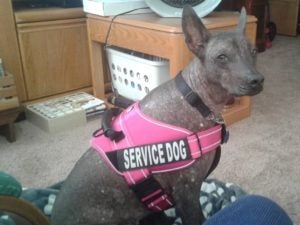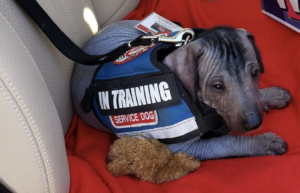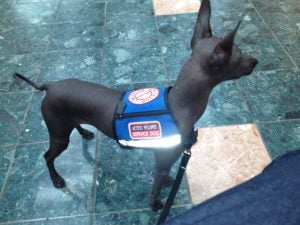
September is National Service Dog Month. This month is dedicated to raising awareness and showing appreciation for the work that service dogs do.
Going Xolo
We often don’t realize what dogs are capable of until a serious situation arises. Such was the case when Stephanie Mazzarella of Amoroso Xolo, a breeder of hairless Xoloitzcuintlis, experienced a severe car accident years ago.
Left with post-traumatic stress disorder and physical ramifications like unexpectedly losing consciousness, Stephanie found herself facing a host of new life challenges. She could no longer go about her daily activities, like shopping, cooking, or driving, without the possibility of passing out.
One day, however, she discovered the invaluable support her own Xolo, Neina, provided. Without any prior training, Neina sensed that her owner was about to lose consciousness, and began barking – before Stephanie herself even knew what was happening. Stephanie awoke to the pup frenetically licking her face, and she realized then that she had a special dog on her hands.
Answering The Call To Service

Stephanie was in awe of Neina’s ability to both understand what was about to happen, and know to take action. Neina’s barking allowed Stephanie to better prepare herself and those around her for the oncoming situation.
“My Neina stepped up and became a service dog that day,” says Stephanie. “I saw my dog’s response to how I acted, and I realized then how smart and in tune Xolos are.”
Stephanie soon took note of Xolos’ ability to help others, as well, when she witnessed one such pup comfort an autistic child by crawling into its lap. After studying up on disabilities and ways in which dogs help, Stephanie made the decision to begin training Xolos as service dogs, with a goal to provide assistance to those who were unsuitable for more common service breeds like Golden Retrievers. This was no easy task, as Xolos don’t share many traits with traditional service dogs.
“Xolos are naturally wary of strangers,” says Stephanie. “They’re still somewhat primitive, and they haven’t been 100 percent domesticated. A Xolo can make a great service animal, but has to be the right dog. I will hold the entire litter and evaluate each one of the puppies to see if they have what it takes to be a service dog.”
With a lot of patience, hard work, and understanding of each dog’s personality, Stephanie was able to uncover the incredible potential that Xolos possess, not just as service dogs, but as therapy dogs as well.
Training Is No Walk In The Park

While Stephanie wouldn’t trade her work with Xolos for anything, there have been some tricky times along the way. For example, when she worked with a school psychologist who wanted a therapy dog for her students, they went through three full litters before finding the right fit, and the training began when the puppy was just weeks old.
“I brought the puppy in to sit in the school library every day, so it could see a multitude of children in one place at four weeks old,” says Stephanie. “Both service dogs and therapy dogs need to be socialized with children at a very young age.”
While the basics of training are consistent with each puppy, Stephanie holds her Xolos to strict standards, including relevant AKC certifications like Canine Good Citizen, advanced obedience training, and completely hands-free training methods.
Each Xolo is trained specifically how to work with their future owner’s individual disability. These roles could include calming an autistic child, or alerting a caregiver to the needs of a disabled adult incapable of communication. In some cases, Stephanie’s Xolos who may not prove the most adept service dogs end up as fine therapy dogs, instead.
A New Avenue For Allergy Sufferers
Perhaps the most meaningful aspects of Xolos in service and therapy work is that those who are severely allergic to dogs often have no trouble being around them. In fact, there are plenty of people in need of a service dog who find themselves unable to own one due to allergies.
In fact, it’s due to her own allergies that Stephanie began breeding Xolos in the first place. She’d always loved dogs and wanted one growing up, but she spent 14 years getting allergy injections and it never solved the problem. Even supposed hypoallergenic dogs brought on her allergic reactions.
“It got to a point where my siblings, desperate for a dog, would joke, ‘Can’t we just get rid of her?'” she recalls.

Upon discovering the hairless Xoloitzcuintli, however, Stephanie realized that she could finally have a dog of her own. From the beginning, she knew she wanted a show dog, but she later discovered the even greater reward of helping other with their life challenges through service dog work.
“I wanted my dog to have a function,” admits Stephanie. “It’s such a rare breed, and many people didn’t even know they existed when I started showing. Since I began training my Xolos as service dogs, though, I’ve gotten so many calls from parents who’ve seen turnarounds in their children immediately. It’s the greatest joy of my life.”

